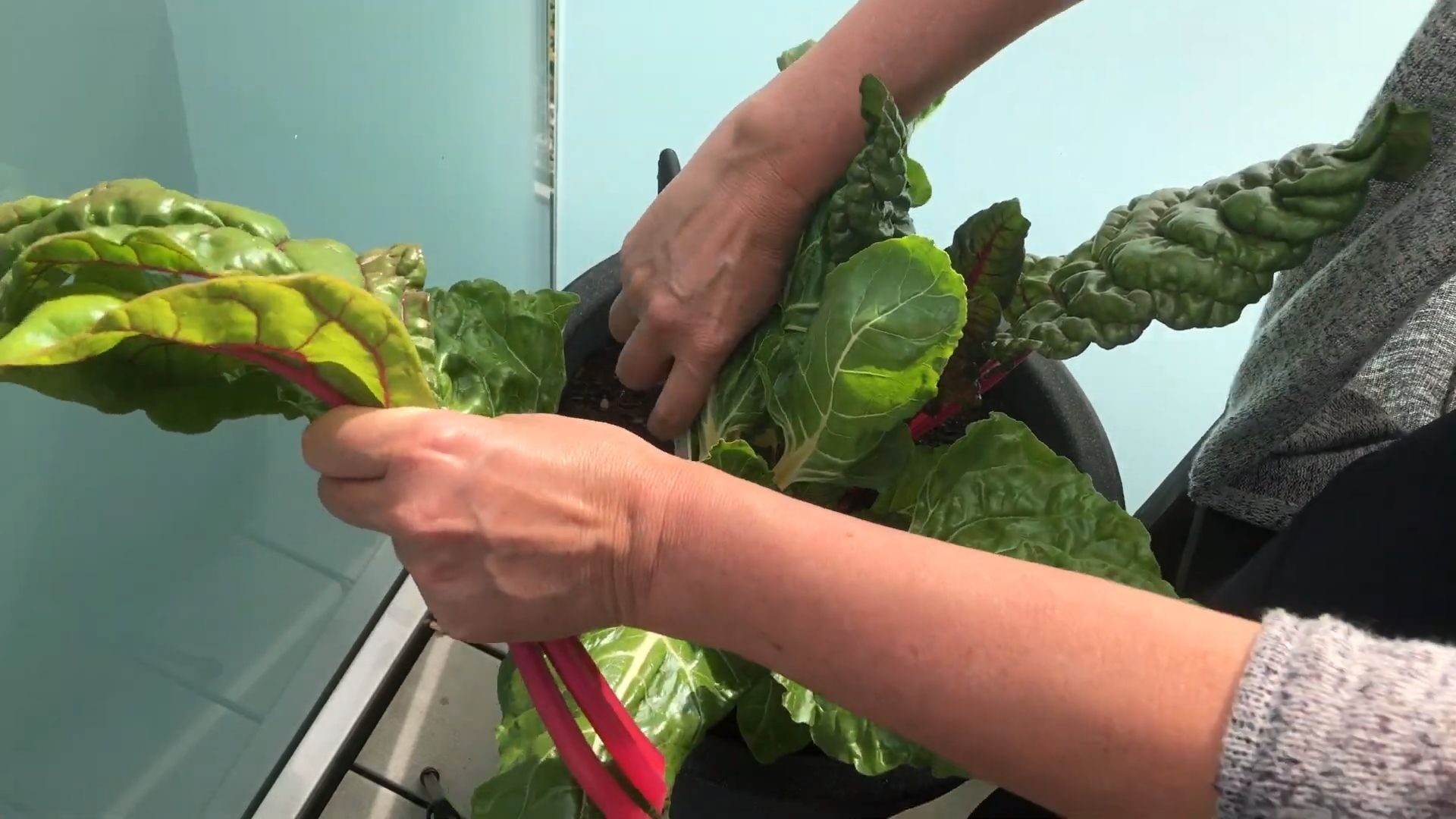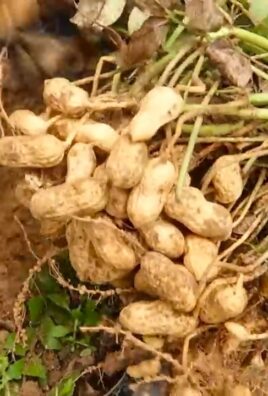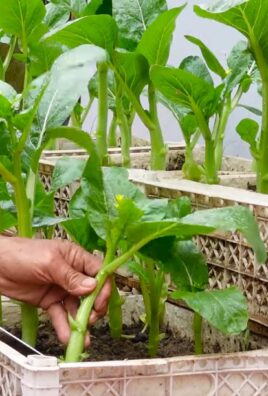Grow Chard at Home? Absolutely! Imagine stepping into your backyard and harvesting vibrant, nutritious chard leaves for a delicious salad or a hearty side dish. It’s easier than you think, and I’m here to show you how with some simple DIY tricks and hacks that will transform your garden into a chard-producing haven.
Chard, also known as Swiss chard, has a rich history dating back to ancient Greece and Rome, where it was valued for its medicinal properties and culinary versatility. For centuries, it’s been a staple in Mediterranean diets, and now, you can bring that same healthy tradition to your own table.
In today’s busy world, we’re all looking for ways to eat healthier and connect with nature. Growing your own chard allows you to do both! Plus, store-bought chard can sometimes be expensive and lack the freshness of homegrown produce. This DIY guide will equip you with the knowledge to grow chard at home successfully, even if you have limited space or gardening experience. I’ll share my favorite tips for soil preparation, planting, watering, and pest control, ensuring you enjoy a bountiful harvest of this leafy green. Get ready to roll up your sleeves and let’s get gardening!

Growing Vibrant Chard at Home: A DIY Guide
Hey there, fellow gardening enthusiasts! I’m so excited to share my experience and guide you through growing your own beautiful and delicious chard right at home. Chard is not only packed with nutrients but also adds a splash of color to your garden or balcony. Trust me, it’s easier than you think!
Choosing Your Chard Variety
First things first, let’s talk about varieties. Chard comes in a rainbow of colors, from the classic green to vibrant reds, oranges, yellows, and even pinks! Here are a few popular choices:
* Bright Lights: This is a showstopper! It boasts a mix of colorful stems, making it a visually stunning addition to any garden.
* Ruby Red: As the name suggests, this variety features deep red stems and veins, adding a rich hue to your dishes.
* Fordhook Giant: If you’re looking for a reliable and productive green chard, this is your go-to. It’s known for its large, tender leaves.
* Lucullus: Another excellent green variety with slightly savoyed (crinkled) leaves and a mild flavor.
I personally love growing Bright Lights because it’s so cheerful! But feel free to experiment and find your favorite.
Getting Started: Seeds vs. Seedlings
You have two options for starting your chard journey: seeds or seedlings.
* Seeds: Starting from seeds is more economical and gives you a wider variety to choose from. However, it requires a bit more patience and attention.
* Seedlings: Buying seedlings from a nursery is a quicker way to get started. Just make sure to choose healthy-looking plants with vibrant leaves.
I usually start from seeds because I enjoy the whole process, but seedlings are a great option if you’re short on time.
Sowing Seeds Indoors (Optional)
If you live in an area with a short growing season, you might want to start your chard seeds indoors 4-6 weeks before the last expected frost. Here’s how:
1. Prepare your seed starting mix: Use a well-draining seed starting mix. You can buy it pre-made or create your own by mixing equal parts peat moss, perlite, and vermiculite.
2. Sow the seeds: Fill seed trays or small pots with the seed starting mix. Sow the seeds about ½ inch deep and 1 inch apart.
3. Water gently: Water the soil gently to moisten it, being careful not to dislodge the seeds.
4. Provide warmth and light: Place the seed trays in a warm location (around 70-75°F) and provide adequate light. A sunny windowsill or a grow light will work.
5. Keep the soil moist: Keep the soil consistently moist, but not soggy.
6. Harden off the seedlings: Before transplanting the seedlings outdoors, gradually acclimate them to outdoor conditions by exposing them to increasing amounts of sunlight and fresh air over a period of 7-10 days.
Planting Chard Outdoors
Whether you started from seeds indoors or bought seedlings, here’s how to plant your chard outdoors:
1. Choose a sunny location: Chard thrives in full sun (6-8 hours of sunlight per day), but it can tolerate partial shade, especially in hotter climates.
2. Prepare the soil: Chard prefers well-drained soil that is rich in organic matter. Amend the soil with compost or well-rotted manure before planting.
3. Space the plants: Space the plants 12-18 inches apart. This will allow them enough room to grow and prevent overcrowding.
4. Dig the holes: Dig holes that are slightly larger than the root ball of the seedlings.
5. Plant the seedlings: Gently remove the seedlings from their containers and place them in the holes. Make sure the top of the root ball is level with the soil surface.
6. Fill the holes: Fill the holes with soil and gently firm the soil around the plants.
7. Water thoroughly: Water the plants thoroughly after planting.
Caring for Your Chard
Once your chard is planted, here’s how to keep it happy and healthy:
* Watering: Water regularly, especially during dry periods. Chard needs consistent moisture to thrive. Aim for about 1 inch of water per week.
* Fertilizing: Fertilize every 4-6 weeks with a balanced fertilizer. You can also side-dress with compost or well-rotted manure.
* Weeding: Keep the area around your chard plants free of weeds. Weeds compete with chard for nutrients and water.
* Mulching: Apply a layer of mulch around the plants to help retain moisture, suppress weeds, and regulate soil temperature.
* Pest Control: Chard is generally pest-resistant, but it can be susceptible to aphids, slugs, and snails. Inspect your plants regularly and take action if you see any pests. You can use insecticidal soap or handpick the pests off the plants.
* Bolting: In hot weather, chard may bolt (go to seed). This will make the leaves bitter. To prevent bolting, provide shade during the hottest part of the day and water regularly. If your chard does bolt, you can still harvest the leaves, but they may not taste as good.
Harvesting Your Chard
The best part! You can start harvesting chard leaves when they are about 6 inches long.
1. Harvest outer leaves: Harvest the outer leaves first, leaving the inner leaves to continue growing.
2. Cut at the base: Cut the leaves at the base of the plant with a sharp knife or scissors.
3. Regular harvesting encourages growth: Regular harvesting will encourage the plant to produce more leaves.
4. Enjoy fresh: Chard is best enjoyed fresh, but it can also be stored in the refrigerator for up to a week.
Troubleshooting Common Problems
Even with the best care, you might encounter a few problems. Here are some common issues and how to address them:
* Yellowing leaves: This could be a sign of nutrient deficiency, overwatering, or underwatering. Check the soil moisture and fertilize if necessary.
* Holes in leaves: This is often caused by slugs or snails. Use slug bait or handpick the pests off the plants.
* Aphids: These tiny insects can suck the sap from the leaves. Spray with insecticidal soap.
* Bolting: As mentioned earlier, bolting can occur in hot weather. Provide shade and water regularly.
Delicious Ways to Enjoy Your Homegrown Chard
Now that you’ve harvested your beautiful chard, it’s time to enjoy it! Here are a few of my favorite ways to use it:
* Sautéed: Sauté chard with garlic and olive oil for a simple and delicious side dish.
* In soups and stews: Add chopped chard to soups and stews for extra nutrients and flavor.
* In salads: Use young, tender chard leaves in salads.
* In smoothies: Add a handful of chard to your smoothies for a healthy boost.
* In omelets and frittatas: Chop chard and add it to omelets and frittatas.
* Stuffed chard leaves: Use chard leaves to wrap fillings like rice, meat, or vegetables.
* Chard chips: Bake chard leaves in the oven for a healthy and crispy snack.
I hope this guide has inspired you to grow your own chard at home. It’s a rewarding experience that will provide you with fresh, healthy, and delicious greens all season long. Happy gardening!

Conclusion
So, there you have it! Growing chard at home is not only surprisingly simple, but it’s also incredibly rewarding. Imagine stepping out into your garden or onto your balcony and harvesting fresh, vibrant chard leaves whenever you need them. No more trips to the grocery store for wilted, overpriced greens! This DIY approach puts you in control of your food source, ensuring you have access to healthy, organic produce right at your fingertips.
But the benefits extend beyond mere convenience. By cultivating your own chard, you’re actively participating in a sustainable lifestyle, reducing your carbon footprint, and connecting with nature in a tangible way. Plus, the taste of homegrown chard is simply unmatched. The leaves are more tender, the colors are more vibrant, and the flavor is bursting with freshness.
This isn’t just about saving money or having access to fresh vegetables; it’s about empowering yourself to create a healthier, more sustainable life. Think of the possibilities! You can experiment with different varieties of chard, from the classic rainbow chard with its colorful stems to the more subtle green varieties. You can even try growing chard in containers on your patio or balcony, making it accessible even if you don’t have a traditional garden.
Consider these variations to elevate your chard-growing experience:
* Succession Planting: Plant new seeds every few weeks to ensure a continuous harvest throughout the growing season.
* Companion Planting: Plant chard alongside other vegetables like carrots, onions, and beans to deter pests and improve soil health.
* Microgreens: Harvest chard leaves when they are young and tender for a nutrient-packed addition to salads and sandwiches.
* Seed Saving: Allow some of your chard plants to bolt (go to seed) and collect the seeds for future planting. This is a great way to save money and preserve your favorite varieties.
Growing chard at home is a journey, not just a destination. There will be successes and challenges along the way, but the rewards are well worth the effort. Don’t be afraid to experiment, learn from your mistakes, and adapt your approach to suit your specific climate and growing conditions.
We wholeheartedly encourage you to give this DIY trick a try. Start small, be patient, and enjoy the process of nurturing your own chard plants. Once you taste the difference between homegrown and store-bought chard, you’ll never look back.
And most importantly, we want to hear about your experience! Share your tips, tricks, and photos with us in the comments below. Let’s create a community of chard-growing enthusiasts and inspire others to embrace the joys of homegrown produce. What are you waiting for? Get planting!
Frequently Asked Questions (FAQ)
What is chard and why should I grow it?
Chard, also known as Swiss chard, is a leafy green vegetable related to spinach and beets. It’s packed with nutrients, including vitamins A, C, and K, as well as fiber and antioxidants. Growing your own chard allows you to have access to fresh, organic produce, save money, and reduce your environmental impact. Plus, homegrown chard tastes significantly better than store-bought varieties.
Is it difficult to grow chard at home?
No, growing chard at home is relatively easy, even for beginners. It’s a hardy plant that can tolerate a wide range of conditions and is relatively pest-resistant. With a little bit of care and attention, you can successfully grow chard in your garden or in containers.
What are the best conditions for growing chard?
Chard prefers full sun to partial shade and well-drained soil. It thrives in temperatures between 60°F and 70°F (15°C and 21°C). However, it can tolerate cooler temperatures and even light frost. Ensure the soil is rich in organic matter and has a slightly acidic to neutral pH.
When is the best time to plant chard?
The best time to plant chard depends on your climate. In cooler climates, you can start seeds indoors 4-6 weeks before the last frost and transplant them outdoors after the danger of frost has passed. In warmer climates, you can sow seeds directly into the garden in early spring or late summer for a fall harvest.
How do I plant chard seeds?
You can sow chard seeds directly into the garden or start them indoors. To sow directly, plant seeds about ½ inch deep and 1-2 inches apart in rows that are 12-18 inches apart. Thin the seedlings to 6-12 inches apart once they have a few true leaves. To start seeds indoors, sow them in seed trays or pots filled with seed-starting mix. Keep the soil moist and provide plenty of light. Transplant the seedlings outdoors once they are large enough to handle.
How often should I water chard?
Chard needs consistent moisture to thrive. Water deeply whenever the top inch of soil feels dry to the touch. Avoid overwatering, as this can lead to root rot. Mulching around the plants can help retain moisture and suppress weeds.
What are some common pests and diseases that affect chard?
Chard is relatively pest-resistant, but it can be susceptible to aphids, flea beetles, and leaf miners. These pests can be controlled with insecticidal soap or neem oil. Diseases such as downy mildew and leaf spot can also affect chard. To prevent these diseases, ensure good air circulation and avoid overhead watering.
How do I harvest chard?
You can begin harvesting chard leaves when they are about 6 inches long. Harvest the outer leaves first, leaving the inner leaves to continue growing. This will allow you to have a continuous harvest throughout the growing season. You can also harvest the entire plant at once if desired.
How do I store harvested chard?
Store harvested chard in the refrigerator in a plastic bag or container. It will keep for up to a week. You can also freeze chard for longer storage. To freeze, blanch the leaves in boiling water for 2 minutes, then plunge them into ice water. Drain well and pack into freezer bags or containers.
Can I eat the stems of chard?
Yes, the stems of chard are edible and delicious! They can be cooked in the same way as the leaves, or they can be sautéed, roasted, or added to soups and stews. The stems may take slightly longer to cook than the leaves.
What are some ways to use chard in cooking?
Chard can be used in a variety of dishes. It can be sautéed, steamed, boiled, or added to soups, stews, and casseroles. It can also be used in salads, omelets, and quiches. Chard pairs well with garlic, onions, lemon juice, and Parmesan cheese.
Is chard a good source of nutrients?
Yes, chard is an excellent source of nutrients. It is rich in vitamins A, C, and K, as well as fiber, antioxidants, and minerals such as magnesium and potassium. It’s a healthy and delicious addition to any diet.
Can I grow chard in containers?
Yes, chard can be successfully grown in containers. Choose a container that is at least 12 inches deep and wide. Fill the container with a well-draining potting mix and plant the chard seeds or seedlings. Water regularly and fertilize every few weeks.
How do I save chard seeds?
To save chard seeds, allow some of your plants to bolt (go to seed). Once the seed pods are dry and brown, harvest them and allow them to dry completely. Then, separate the seeds from the pods and store them in an airtight container in a cool, dry place.
What are some different varieties of chard?
There are many different varieties of chard available, including rainbow chard, Fordhook Giant, Lucullus, and Bright Lights. Rainbow chard is known for its colorful stems, while Fordhook Giant is a large, productive variety. Lucullus is a tender and mild-flavored variety, and Bright Lights is a mix of different colored chard varieties. Experiment with different varieties to find your favorites.





Leave a Comment